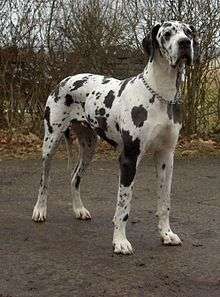Giant dog breed
There is no universal height or weight at which a breed is classified as a giant dog breed; any very large dogs fall into this category, although some groups define "giant breeds" as those heavier than 50 kilograms (110 lb). Giant breeds grow rapidly, but take longer to mature into their full adult sizes than smaller dogs.[1]
Advantages and disadvantages
Many giant breeds are mature, soft and relaxed dogs as adults and require less exercise than most smaller dogs, so they may make better pets for small living arrangements, such as apartments. Because they are larger animals, they are less intimidated by other people and thus are much more adaptable to meeting friends, family members, and children of owners. They are normally very calm and are great family dogs. They are also, by definition, stronger and bigger than other breeds. If they sense a threat towards their owner, they will become very protective. Many of the giant breeds are known for their protection and life-saving abilities.[2]
Giant breeds often have health-related disadvantages when compared to smaller dogs and caring for them is usually more expensive than for smaller dogs.[2] They eat more than smaller breeds and sometimes require specialty diets to tackle weight and joint management.[3]
In addition to spending more on food, expenses overall may be more than for most breeds. Larger beds, collars, and toys cost more, as do grooming and kenneling very large dogs. There is also the issue of more expensive veterinary bills. For instance, anaesthetics and pharmaceuticals are charged by volume/mass, which is determined by the weight of the dog. Joint problems, such as hip dysplasia and arthritis, are common.[1] Large breeds are also quite prone to osteosarcoma and susceptible to other debilitating bone and cartilage diseases. This is the result of a much higher growth factor—adult weight versus birth weight—and much longer growth period.[4] Their life span is generally shorter than that of smaller dogs, often living only 6 to 10 years.
Weight records
- 2012: 343 lbs (155.6 kg), an English Mastiff named Zorba, from the U.K., and measured almost 8 feet long from nose to tail.[5]
- A St. Bernard named Benedictine holds the world record for the heaviest dog ever. Benedictine, who displaced Zorba as the heaviest dog of all time, is said to have weighed 166 kilograms (366 lb).[6][7]
- Giant George
Giant breeds
The following breeds are generally described as giant breeds:
- Akbash Dog
- Alaskan Malamute
- German Shepherd Dog
- American Akita
- American Bulldog
- Anatolian Shepherd
- Armenian Gampr dog
- Bernese Mountain Dog
- Black Russian Terrier
- Bloodhound
- Boerboel
- Borzoi
- Brazilian Mastiff
- Bullmastiff
- Bully Kutta
- Cane Corso
- Caucasian Shepherd Dog
- Central Asian Ovcharka
- Dogue de Bordeaux
- Dobermann Pinscher
- Dogo Argentino
- English Mastiff
- Estrela Mountain Dog
- Georgian Shepherd
- Giant Schnauzer
- Great Dane
- Great Pyrenees
- Greater Swiss Mountain Dog
- Irish Wolfhound
- Kangal Dog
- Komondor
- Kuvasz
- Laika
- Leonberger
- Maremma Sheepdog
- Neapolitan Mastiff
- Newfoundland
- Old English Sheepdog
- Presa Canario
- Pyrenean Mastiff
- Rafeiro do Alentejo
- Rhodesian Ridgeback
- Rottweiler
- Saint Bernard
- Scottish Deerhound
- Spanish Bulldog
- Spanish Mastiff
- Šarplaninac
- Tibetan Mastiff
- Tosa Inu
References
- 1 2 Fogle, Bruce (2000). "The Skeleton". The New Encyclopedia of the Dog. Dorling Kindersley. p. 47. ISBN 0-7894-6130-7.
- 1 2 Mehus-Roe, Kristin (2005). "The Dog For You". The Original Dog Bible. BowTie Press. pp. 62–63. ISBN 1-931993-34-3.
- ↑ "Dog Health Issues - Giant and Large Breed Health Issues - Canada's Guide to Dogs". Retrieved 2 February 2016.
- ↑ Royal Canin
- ↑ "Biggest Dog World Record". Retrieved 2 February 2016.
- ↑ "World’s Largest Dog Breeds". Retrieved 2 February 2016.
- ↑ Benedictine (St. Bernard), the world's heaviest and largest dog ever

